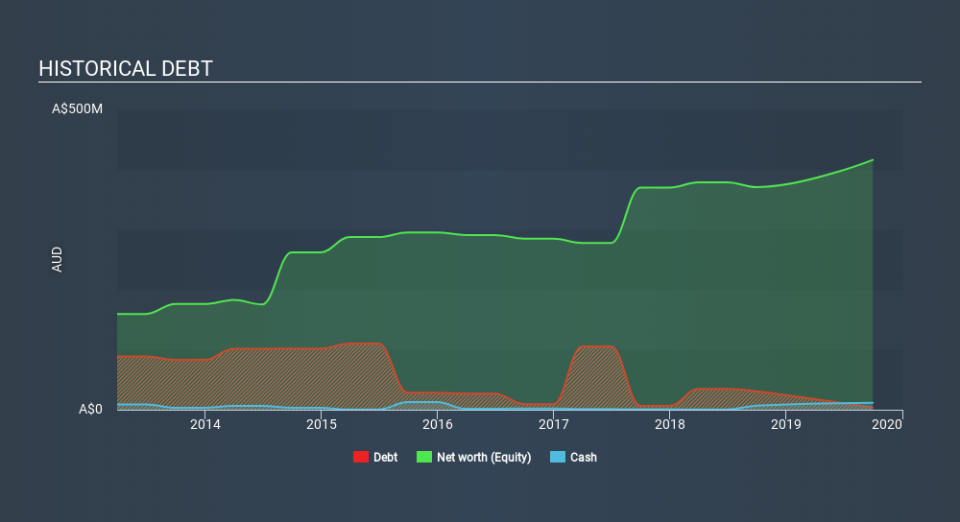Select Harvests (ASX:SHV) Seems To Use Debt Quite Sensibly

The external fund manager backed by Berkshire Hathaway's Charlie Munger, Li Lu, makes no bones about it when he says 'The biggest investment risk is not the volatility of prices, but whether you will suffer a permanent loss of capital. So it seems the smart money knows that debt - which is usually involved in bankruptcies - is a very important factor, when you assess how risky a company is. Importantly, Select Harvests Limited (ASX:SHV) does carry debt. But the more important question is: how much risk is that debt creating?
What Risk Does Debt Bring?
Debt is a tool to help businesses grow, but if a business is incapable of paying off its lenders, then it exists at their mercy. Part and parcel of capitalism is the process of 'creative destruction' where failed businesses are mercilessly liquidated by their bankers. However, a more common (but still painful) scenario is that it has to raise new equity capital at a low price, thus permanently diluting shareholders. Of course, the upside of debt is that it often represents cheap capital, especially when it replaces dilution in a company with the ability to reinvest at high rates of return. When we think about a company's use of debt, we first look at cash and debt together.
Check out our latest analysis for Select Harvests
What Is Select Harvests's Debt?
You can click the graphic below for the historical numbers, but it shows that Select Harvests had AU$3.64m of debt in September 2019, down from AU$30.7m, one year before. However, its balance sheet shows it holds AU$11.6m in cash, so it actually has AU$7.95m net cash.
How Healthy Is Select Harvests's Balance Sheet?
Zooming in on the latest balance sheet data, we can see that Select Harvests had liabilities of AU$63.5m due within 12 months and liabilities of AU$73.4m due beyond that. Offsetting this, it had AU$11.6m in cash and AU$30.2m in receivables that were due within 12 months. So it has liabilities totalling AU$95.1m more than its cash and near-term receivables, combined.
Of course, Select Harvests has a market capitalization of AU$678.1m, so these liabilities are probably manageable. But there are sufficient liabilities that we would certainly recommend shareholders continue to monitor the balance sheet, going forward. While it does have liabilities worth noting, Select Harvests also has more cash than debt, so we're pretty confident it can manage its debt safely.
It was also good to see that despite losing money on the EBIT line last year, Select Harvests turned things around in the last 12 months, delivering and EBIT of AU$80m. There's no doubt that we learn most about debt from the balance sheet. But it is future earnings, more than anything, that will determine Select Harvests's ability to maintain a healthy balance sheet going forward. So if you want to see what the professionals think, you might find this free report on analyst profit forecasts to be interesting.
Finally, a business needs free cash flow to pay off debt; accounting profits just don't cut it. While Select Harvests has net cash on its balance sheet, it's still worth taking a look at its ability to convert earnings before interest and tax (EBIT) to free cash flow, to help us understand how quickly it is building (or eroding) that cash balance. Over the most recent year, Select Harvests recorded free cash flow worth 54% of its EBIT, which is around normal, given free cash flow excludes interest and tax. This free cash flow puts the company in a good position to pay down debt, when appropriate.
Summing up
While Select Harvests does have more liabilities than liquid assets, it also has net cash of AU$7.95m. So we don't have any problem with Select Harvests's use of debt. When analysing debt levels, the balance sheet is the obvious place to start. But ultimately, every company can contain risks that exist outside of the balance sheet. Take risks, for example - Select Harvests has 2 warning signs we think you should be aware of.
When all is said and done, sometimes its easier to focus on companies that don't even need debt. Readers can access a list of growth stocks with zero net debt 100% free, right now.
If you spot an error that warrants correction, please contact the editor at editorial-team@simplywallst.com. This article by Simply Wall St is general in nature. It does not constitute a recommendation to buy or sell any stock, and does not take account of your objectives, or your financial situation. Simply Wall St has no position in the stocks mentioned.
We aim to bring you long-term focused research analysis driven by fundamental data. Note that our analysis may not factor in the latest price-sensitive company announcements or qualitative material. Thank you for reading.

 Yahoo News
Yahoo News 
